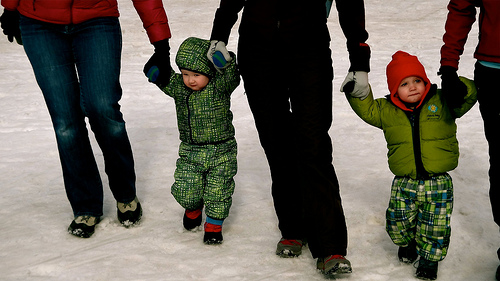One thing I’m really into, and have been since high school, is photography. In fact, some people think I had a kid just to gain a captive photo subject. While that’s not true (we did it for the tax deduction) I take a lot of photos of my son. A few weeks ago I spoke with my friend, Reno Collective member, and photographer, David Calvert to get some tips for taking better family photos during holidays, family gatherings and vacations.
Over the last few years, Facebook and other online gallery tools like Flickr and Picasa have overtaken prints and albums for sharing and presenting family photos. Because of commenting, tagging and sharing, telling a story with your photo galleries is much easier than it used to be and takes a slightly different approach to family photography.
Get the candid moments

“Candid moments are real moments,” says Calvert. Get photos of your family hanging out and having a good time: get Mom with her arms inside a turkey, Dad watching football. Calvert is a journalist photographer and he suggests the following.
• Avoid poses: “Photograph your family doing something.”
• Get a lot of different angles: “Move. Dance about the scene. When I shoot events I’m always moving.”
• “Have your camera up and ready.” The good shots can sneak up on you.
• “Shoot a lot.” Digital images are free.
Don’t use the flash
The flash intrudes on the real moments both visually and physically. “Uncle Joe has a mullet because of the angle of the flash,” says Calvert. “People see the flash and they start paying attention to it.” Then they start posing in unnatural ways because you’re interrupting the situation.
• Look for natural light: Light bouncing off a white wall from table lamps and overhead lights
• Look for soft light: open shade outside or diffused light inside
• Turn off the flash: look for the circle with a thunderbolt on your camera’s screen or menu, when it’s off there will be a slash through it.
• If it’s too dark inside, go outside.
• If you have a DSLR use the flash but turn the camera upside down for fewer shadows.
Keep it simple
“The lower end DSLRs (these are the big cameras with interchangeable lenses) are worse image quality than the higher end point and shoots,” Calvert believes. The lenses that come with the entry level DSLR packages are not suited to indoor shooting due to the limited minimum aperture (they don’t let in as much light). They also have generally poorer glass which greatly affects your images.
If the kid wants to cry, let him cry

“Little kids do goofy stuff, and they cry when they’re not supposed to and the laugh loud and they laugh hard,” Says Calvert. “You want pictures of that. People like that.” It’s not what you might think would be a good photo, but it’s perfect for telling the story, and you’ll be happy to have the image. “My favorite pictures of kids with santa clause are ones where the little kid’s crying,” Calvert adds. “Cause it’s real.”
Get closer OR Get farther away

“Don’t shoot everything form one angle, don’t shoot everything from one focal length,” Calvert says. Move in, out, up and down to capture the scene and the how the people interact with it and each other.
- Get up on a chair
- Zoom out and move in closer, let people fill the screen: “get personal”
- Zoom in and move back: “create a sense of place”
- “All of this adds visual variety.”
Pay attention to the backgrounds

“You don’t want a lot of clutter,” Calvert says. “You can clean up your backgrounds by getting up high or getting down low.”
Get detail shots

It can also be useful to think about zooming in to get extreme close ups or detail shots. “Hand photos are great,” says Calvert. “If you’ve got a picture of your 5 year old daughter holding her grandmas hand, just focused on the hands, that says a lot right there.”
Natural environment

If you want to shoot family portraits, think about how location affects the attitude of the subject. Calvert says that a lot of times people will take their kids to a park or some other unfamiliar place for portraits. “Maybe you should photograph them on the front porch. Photograph your kids in their room. Have them show you their stuff. That’s a real photo, those are real emotions.”
Let your kids take the pictures
Your personal perspective influences what you take photos of. To complete the picture, If you have a camera that can take the abuse, or if your kids can be trusted with the equipment, let them take pictures. “You’ll be surprised with what they get,” says Calvert.
Check out David Calvert’s photos and blog.
-Mike
This article originally appeared in the Reno Nevada family magazine, Family Pulse.







Add comment